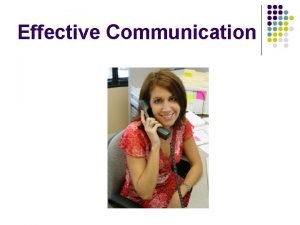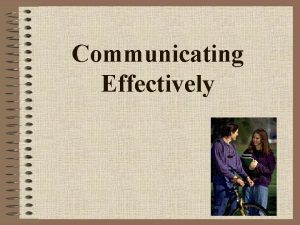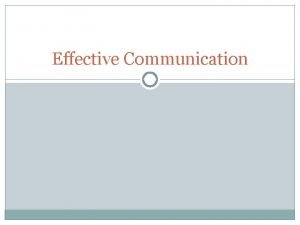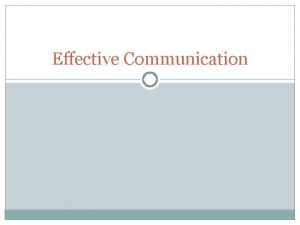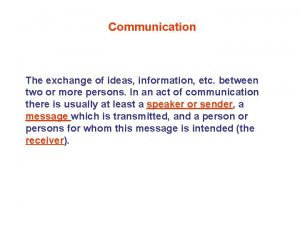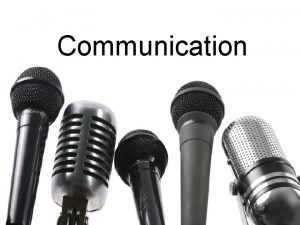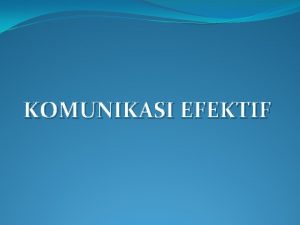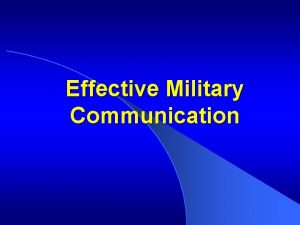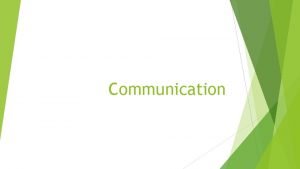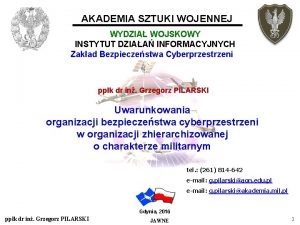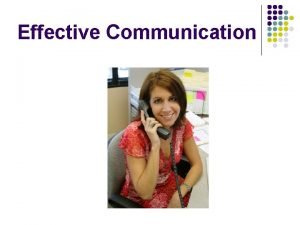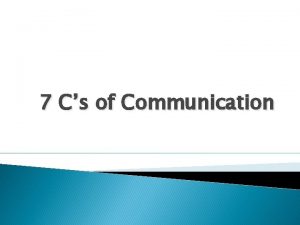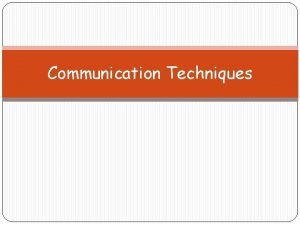Effective Communication Communication exchange of information thoughts ideas

























- Slides: 25

Effective Communication

Communication: exchange of information, thoughts, ideas, and feelings Verbal Non-verbal Spoken words Facial expressions Written Body language communication touch

3 essential elements: • Sender • Individual who creates a message to convey information or ideas to another person • Message • Information, idea or thought • Receiver • Individual who receives the message from the sender Feedback is a method that can be used to determine if communication was successful. Occurs when the receiver responds to the message Allows the original sender to evaluate how the message was interpreted and to make any necessary adjustments or clarification. Feedback can be verbal or non-verbal.

Elements of effective communication: • THE MESSAGE MUST BE CLEAR (USE OF TERMINOLOGY BY BOTH PARTIES; EXPLAINING PROCEDURES IN LAY TERMS) • THE SENDER MUST DELIVER THE MESSAGE IN A CONCISE MANNER (CORRECT PRONUNCIATION AND GOOD GRAMMAR) • THE RECEIVER MUST BE ABLE TO HEAR AND RECEIVE THE MESSAGE (HEAVILY MEDICATED PATIENT WON’T HEAR MESSAGE; HEARING/VISUAL IMPAIRMENTS; FOREIGN LANG. ) • THE RECEIVER MUST BE ABLE TO UNDERSTAND THE MESSAGE (ATTITUDES/PREJUDICE; ASK QUESTION TO MAKE SURE MESSAGE IS UNDERSTOOD) • INTERRUPTIONS OR DISTRACTIONS MUST BE AVOIDED (TALKING WHILE ANSWERING THE PHONE; LOUD NOISES, UNCOMFORTABLE TEMPERATURE)

Communication process Listening Non-verbal communication Paying attention to and Involves use of facial making an effort to hear what the person is saying Allows you to perceive the entire message that a person is trying to convey expressions, body language, gestures, eye contact and touch Health care worker must be aware of both their own and patient’s nonverbal behavior

Barriers to communication • Something that gets in the way of clear communication • Three common barriers: • Physical disabilities • Psychological attitudes/prejudice • Cultural diversity

Barriers (continued) Physical disabilities Psychological Deafness/hearing loss Caused by prejudice, Blindness/impaired vision Aphasia/speech impairments attitudes and personality Moralizing Lecturing Over-reacting Arguing Prejudging Advising

Barriers (continued) Cultural Diversity Beliefs regarding health care Language differences Eye contact Ways of dealing w/ terminal illness and/or severe disability Touch

Recording & Reporting Must record and report all observations while providing care Must listen to what patient is saying, but observe with other senses as well

Types of observation Subjective Objective Cannot be seen or felt Can be seen or Commonly called measured Commonly called signs symptoms Usually statements or complaints made by patient/resident Report in exact words

Recording/documentation Written observations must be accurate, concise and complete as well as neat and legible Spelling and grammar should be correct Only objective observations should be noted Subjective data that the health care worker feels or thinks should be avoided Errors should be crossed out neatly with a straight line, have “error” recorded by them, and initials of the person making the error

Telephone communication Do not give info about Be cheerful when staff or residents over the phone Place caller on hold if you need to get someone to take the call Follow facility policy on personal phone calls greeting a caller Identify your facility Identify yourself and your position Listen closely to caller’s request Get telephone number Say “thank you” and “good-bye”

Guidelines for good communication Hearing impairment Make sure hearing aids working well (batteries) Reduce noise in room Get resident’s attention before speaking Speak slow, clear and in good lighting Directly face person Do not shout Lower pitch of your voice Do not chew gum Keep hands away from face Repeat using different words Use picture cards or notepad if needed Don’t get frustrated

Vision impairment • Make sure glasses are clean • Identify yourself and explain what your doing • Provide good lighting • Orient person to time and place if needed • Use the face of imaginary clock as a guide to explain the position of objects in front of the resident • Do not move personal items or furniture without the resident’s knowledge • Offer large-print newspapers/magazine • Use large clocks in room • Get books on audiotape

Stroke & communication occurs when a clot or a ruptured blood vessel suddenly cuts off blood supply to the brain Depends on severity of stroke Keep questions and directions simple Phrase questions so they can be answered with “yes” or “no” Agree on signals such as shaking or nodding head Use pencil and paper if resident able to write Never call weaker side “bad side” Use picture, gestures or pointing (communication boards or special cards to aid communication work well) Keep call signal within reach and let them know you will come when they need you

Combative resident can result from disease process affecting the brain, frustration, or part of personality Block physical blow or step out of way Stay at a safe distance Stay calm Be flexible and patient Be neutral Do not respond to verbal attacks (don’t argue) Do not use gestures that could frighten/startle resident Be reassuring and supportive Leave resident alone if you can safely do so

Angry behavior Disease process, fears, pain and loneliness Stay calm Do not respond to verbal attacks – don’t argue Empathize with the resident Try to find cause of anger Treat resident with dignity and respect Answer call light promptly Stay at a safe distance if resident becomes combative

Inappropriate Behavior Includes sexual advances and comments; residents removing clothes or touching themselves (Illness, dementia, confusion and medication) • Don’t over-react • Try to distract resident • Notify the nurse • Problems may mimic inappropriate behavior: clothes too tight, rash, too tight, etc.

Documentation OBSERVATION, REPORTING & DOCUMENTING

Nursing Process The RN is responsible for achieving “patient focused care” (you learned this in Role of NA) He/she coordinates and delegates to other caregivers Consists of 5 steps: Assessment Collect data about patient/resident (interviews, records, family & physical examination) Patient has surgical incision due to hip replacement Problem identification “nursing diagnosis” – statement of patient problem; provides foundation for nursing care Rick for infection related to surgical incision

Nursing Process continued Planning Implementation Care of the patient - “care plan” – identifies possible solutions to the identified problem within scope of practice Establishes goals for the patient May be kept in a file or “kardex” Assess for s/s of infection q 4 h Carrying out the approaches listed on the care plan to help patient reach the goal Documentation q 4 h of assessment for infection in kardex Evaluation Ongoing; determines whether patient is reaching goals; can be extended if need and goals can be changed when condition changes no fever noted on vital signs sheet, no drainage from surgical site, etc.

Types of forms used in documentation Admission History/physical exam Care plans Doctor’s orders Doctor’s progress notes Nursing assessment (MDS) Nurse’s notes Flow sheets Graphic record Intake/output record Consent forms Lab/test results Surgery reports Advance directives

Check for right patient, room, Charting Guidelines “If it’s not charted, it’s not done” Purpose is to record patient care and prove accountability for care given form, & chart Fill out completely Correct color of ink Correct sequence of events Correct spelling Correct entries (brief/accurate) facts/not opinions DO NOT Use “ditto” marks Use term patient Use white-out for corrections Single line through error with initials

Military Time clock Facilities use 24 -hour clock to reduce confusion in am/pm hours. To change hours simply add 12 to the original hour: 3 + 12 = 15 3: 00 pm = 1500 hours Hours from 12: 00 am – 12: 00 pm are written as 00: 01 -1200

Accident or unexpected event that Incident reports happens during care given Feeding a resident from the wrong tray Fall or injury to the resident Accusation against a staff member by a family State & Federal guidelines to fill out incident report documenting facts about what happened State what happened, time, place, condition of resident State facts, not opinions Do not write in medical record Describe action taken Include suggestions for change
 Communication exchange of information
Communication exchange of information Communication is the exchange of information
Communication is the exchange of information Communication exchange of information
Communication exchange of information The exchange of information thoughts ideas and feelings is
The exchange of information thoughts ideas and feelings is What are the factors of communication
What are the factors of communication It is the exchange of thoughts message or information
It is the exchange of thoughts message or information My thoughts are higher than your thoughts
My thoughts are higher than your thoughts Aktivitas pertukaran ide atau gagasan disebut
Aktivitas pertukaran ide atau gagasan disebut Military effective communication
Military effective communication Transforming thoughts ideas and
Transforming thoughts ideas and Foreign exchange means
Foreign exchange means Real exchange rate vs nominal exchange rate
Real exchange rate vs nominal exchange rate Voluntary exchange
Voluntary exchange Gas exchange key events in gas exchange
Gas exchange key events in gas exchange Exchange of feelings and attitudes
Exchange of feelings and attitudes Ideas have consequences bad ideas have victims
Ideas have consequences bad ideas have victims Ideas secundarias
Ideas secundarias Crisp health information exchange
Crisp health information exchange Information exchange gateway (ieg)
Information exchange gateway (ieg) Aeronautical information exchange model
Aeronautical information exchange model Supervisor information
Supervisor information Law enforcement information exchange
Law enforcement information exchange Microfinance information exchange
Microfinance information exchange Linx law enforcement
Linx law enforcement Maryland health information exchange
Maryland health information exchange Care information exchange
Care information exchange
